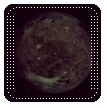
 Theory
Theory 
 Solar System Moons
Solar System Moons
| CONTENT - All about moons of the solar system planets |
| |
Theory
Moons in the solar system are of three types: regular, irregular, inner
- regular satellites, most of the time, are the first moons which were discovered at a planet. The four Galilean satellites of Jupiter or the usual moons of Saturn are a good example. Such satellites have steady, almost circular, orbits which are nearly all situated in planet's equatorial plane. This may be a hint to that this kind of moons formed at the same time than the planet did. Some of these moons like our Moon or some satellites of Uranus may result from a collision. Charon, the moon of Pluto might result from a collision too or both bodies might better be a binary planetary system as both are orbiting around a common point. Triton, the main moon to Neptune might be a captured body
- irregular satellites are small, rocky bodies, resulting of ancient collisions between planet's original moons and passing comets and asteroids, or they are bodies (asteroids, Centaurs) captured from an independent orbit. Some are close together, possibly being fragments of a same original object. Irregular satellites are small in size, they are orbiting at great distances from the planet, and they often have odd orbits (very elliptical, inclined compared to the plane where are found most of other moons, or retrograde). These irregular moons mark their planet's gravitational field's outer limit (what is called the Hill's sphere) and new imagery techniques are constantly increasing their number
- inner satellites (also said ring moons) are located amid rings with other debris and are surely the most recent moons of a planet. Their greater proximity to their planet was risky as far as giant planets are concerned as gas giants then were attracting comets and other solar system formation leftovers. Odds were great that these moons be destroyed. Much further as these moons were close to their planet, orbiting swiftly, as they were often small bodies with a weak gravity. Consequences of collisions were increased. Such inner moons are often interacting with the planet's rings. The best example is at Saturn
Many Kuiper Belt objects (KBOs) are binary objects; some planets have so-called Trojan satellites which are in clouds ahead and behind the planet at Lagrangian points L4 and L5; odd objects like Cruithne -which is an horseshoe orbit objects- or like 2002AA29 -a co-orbital object to Earth- are found too
 | Ganymede, a moon of Jupiter. picture site 'Amateur Astronomy', based on Celestia |
Compared Sizes, Data
 check tables and size comparison charts for the moons in the solar system (note: all values in the metric system!)
check tables and size comparison charts for the moons in the solar system (note: all values in the metric system!)
Planets Moons System Quick Overview
Moons are scant or specific, like the Moon, in the inner solar system. In the world of the outer gas giants most moons system are alike with inner moons linked to the rings, major -or regular- satellites having interesting surface features and aspects, and outer, irregular, moons orbiting far from the planet. Pluto, the lone, faraway planet, has one main moon only, Charon, and 4 diminutive satellites. Based on estimates of comet populations, some moons in the outer solar system have been hit by comets, smashed apart, and re-accreted multiple times
- Nor Mercury or Venus have any moon, albeit some diminutive one has been lately discovered at Mercury
- Earth has only one satellite: our Moon
- Mars had two small irrgular satellites, Phobos and Deimos, orbiting in mostly equatorial orbits as one thinks they might be mere asteroids captured. Like some asteroids they would thus be mostly piles of rubble
- Jupiter has mainly three sets of moons: inner small moons linked to the faint ring system; the four Galilean satellites, large satellites ranging from Io to Callisto and tidally affected by the gas giant. And a long series of small, outer, irregular moons
- Like Jupiter, Saturn possesses small inner satellites linked to the ring system as Titan largely dominates in size a series of major satellites. The remaining is a long series of small, outer, irregular satellites
- Five major satellites, from Miranda to Oberon, are found at Uranus, similar in size to the main satellites of Saturn. They are part water ice and other ices, part rocky material. Miranda and Ariel are very complex and are ill-understood probably having had an history linked to tidal heating. Smaller satellites are linked to the ring system and some irregular moons are found in outer orbits
- Triton is the largest moon of Neptune and probably a captured planetesimal, with frosts of various elements at its surface and high plumes like at Io. Proteus and Nereid are the two other main satellites as five smaller moons are linked to Neptune's ring and small outer, irregular moons were recently found
- Pluto has one moon only, Charon as four diminutive moons have been discovered lately
Website Manager: G. Guichard, site 'Amateur Astronomy,' http://stars5.6te.net. Page Editor: G. Guichard. last edited: 12/28/2010. contact us at ggwebsites@outlook.com


![]() check tables and size comparison charts for the moons in the solar system (note: all values in the metric system!)
check tables and size comparison charts for the moons in the solar system (note: all values in the metric system!)